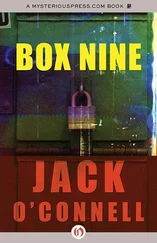Jakob is sitting fifty feet above the ground, his legs dangling toward the fastest lane of the interstate. He’s perched on the small lip of steel staging that supports an enormous billboard that reads
Aldrich Brothers Opticians
in the lobby of the Justman Building
“Because We’ll See You Through”
From this height and distance, he can get a beautiful wide-angle of Gompers and he knows, if he can make it haunting enough, this is the shot he’ll use to both open and close his film.
Jakob has been sitting up on the billboard lip for almost an hour. He keeps staring out over the train station with his bare eyes, then lifting the Seitz and staring all over again through the camera’s eye. Something is troubling him, but he’s yet to discover what it is. It’s an absence of some sort, a missing component to the total picture. It’s something he knows, instinctively, in his gut, that he can correct. It’s a hole that needs to be filled, some kind of minor element like a truant wine bottle that should be in the rail bed, a pane of glass that needs to be broken. If he’s patient and sits long enough, the gap will reveal itself. Sometimes there’s nothing else you can do.
It would have been easier in Maisel, he thinks, but ease is not what makes a great film. Quinsigamond is a deranged stepmother with very sharp claws. But this is why it’s the perfect place, the only place, to film Little Girl Lost.
He takes in the night air, thick with the rain that keeps threatening to fall, arches his shoulders backwards and wonders how Felix will dispose of Jiri Fric’s body. Then he pushes the thought away and lifts the Seitz back to his eye, peers through, aiming down at the station. And, for the first time all night, he sees movement.
He zooms in and adjusts his focus manually. There, poking out of one of the Saville Co. Storage cars. And she’s gone before he can shoot any film. He shifts the camera up on his shoulder, points it skyward, looks over the whole of the lot. He brings the camera back, aims at the storage car, waits ten seconds. Waits another twenty. There, again, the head edges out beyond the door, furtive, like an animal aware of an unseen predator.
The head lingers this time. It’s a young girl, preteen. She takes another look around the yard, then shifts her body, throws her legs out the door and eases herself down to the ground, in an anticipatory crouch. Then, as if a switch is thrown, she bolts toward a waste Dumpster across the yard, hauls herself up by climbing a pile of scrap metal next to the bin, and rolls like a gymnast down into the trash, disappearing from the frame completely.
Jakob’s heart is racing with epiphany. This is the face he has been looking for, the saint that will bless his film. This is, without doubt, without any equivocation, the face that will fuel every inch of celluloid he’ll expose. This is the Little Girl Lost.
All he’ll need is a single, perfect, still shot. Something he can blow up to wall-size for the chancellery interrogation scene and integrate into the newspaper mock-ups. Something he can transpose, full-screen, a ghost-image, over the anti-hero’s final moments.
And then he’s climbing, racing down the struts of the billboard like some arrogant prince of a traveling circus who has nothing but contempt for gravity. He leaps the last five feet to the breakdown lane of the highway, cradling the Seitz like a baby pulled from a burning tenement. He dashes across the interstate, ignoring the awful horn blast of the refrigeration trucks barreling down on him. He jumps over the guardrail, does a graceless, full-speed dance down the embankment that rolls into the perimeter of Gompers. And then he freezes, not sure how to proceed. If he rushes her, he’ll panic her back into hiding and lose his central image forever. But if he calls out to her, gives her warning, she’ll have even more time to cut and run. So he decides the best thing to do is probably keep his distance, but follow her, wait for her to appear in some random shaft of light, and shoot as much film as he can without her ever knowing,
He moves as quietly as possible, positions himself behind an Elias Freight boxcar. He gets on one knee, brings up the Seitz and finds his focus. And then he finds the girl. Incredibly, she’s even better in closer proximity, matching, almost too well, the rough sketches he made in the back of his notebook. She has the kind of eyes that make dialogue irrelevant. The flowing blonde hair, matted now in places, that gives her a vulnerable but feral look. She’s dressed in filthy clothing that looks like cast-off rags.
Jakob watches as she begins to chew on something found in the Dumpster, maybe a crust of bread. She tears into it with her teeth, pushing it into her mouth until the cheeks bulge like those of a squirrel. Her skin is smudged with ash and dirt and Jakob thinks it could be deliberate, a crude camouflage or war paint.
The girl makes a hard swallow, stuffs a pocket with something unrecognizable. Then she climbs back to the ground, stunningly agile, and makes a beeline for the interior of Gompers. She enters through a low window hole that’s been halfheartedly boarded over. Jakob gives her a few seconds’ head start, then follows.
But he finds he can’t fit through the gaps in the plywood, so he circles around the side of the station and finds a hole that’s been smashed through the marble wall. He gets down on his knees, blankets the camera inside his jacket, and climbs through.
Jakob enters the main chamber of the station and stops, stays motionless and tries to get a fix on where the girl has gone. He smells smoke, hears the sound of running feet from above. He sees the remains of a huge support column to his right and crawls toward it on all fours, then eases himself into sitting and withdraws the Seitz from the fold of his coat. He brings the camera to his eye and pulls back to a medium shot, then begins to scan the balconies that rim the main chamber.
At the far end of the hall, he fixes on a small bonfire. He pulls in slightly, finds faces illuminated in the glow of the fire’s light. They’re all children, both girls and boys. In the center of the group is his star, the engine of his movie, the face that will only appear in reproduction, a still, fixed image. But, Jakob knows, even in this ridiculous dimness, that the power of this child’s face will certainly outshine every scenery-chewer slated to walk across the screen.
The little girl is handing out to her compatriots whatever she scavenged from the Dumpster outside. She works deliberately, with a seriousness of purpose far beyond what her age should allow. Every now and then, she stops to rub her eyes or bring the back of her hand across her nose.
This lighting isn’t going to work, Jakob thinks. And the distance is too great.
He’s going to need to shoot her during the day somehow. And to do that, sooner or later, he’s going to have to approach her. He comes back up onto his knees and starts to move for a closer column, but his hand hits something cold and metal and sends the object rolling down a slope of broken concrete. The noise echoes through the chamber and the children up in the balcony immediately scatter, one of them dousing the fire with tossed liquid.
Jakob cringes and curses himself. He stands up, shoulders the Seitz, looks through the lens and sweeps across the balconies. And he’s shocked to find himself staring up at a young boy, barely a teen. But as Jakob starts to sharpen his focus, the kid pitches a rock. The stone impacts at Jakob’s feet, but it’s just the initial assault in what suddenly becomes a barrage. From every angle above, rocks and bottles and lengths of pipe come hurling through the air down around Jakob. An old boot catches him across the forehead and he falls intentionally to the ground and starts to crawl for shelter.
Читать дальше











